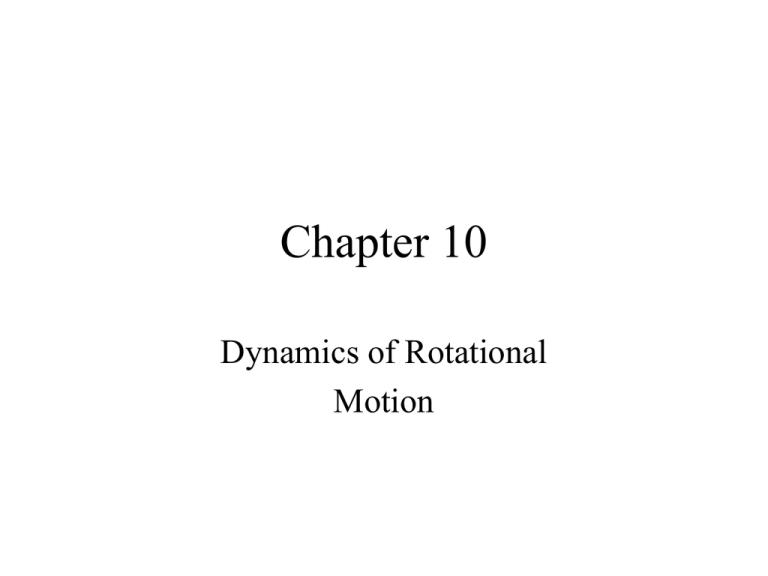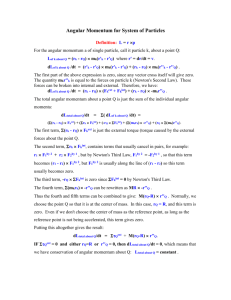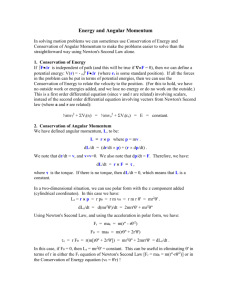Chapter 10 - Physics | SIU
advertisement

Chapter 10 Dynamics of Rotational Motion Torque • Definition: • A force can be defined as something that causes linear motion to change. • A torque can be similarly defined as something that causes a change in rotational motion. • The torque applied to a rigid body depends on the magnitude of the applied force, the distance away from the point of rotation ( lever arm), and the direction of the applied force. • We can express the torque as a vector cross product. Example • The Achilles tendon of a person is exerting a force of magnitude 720 N on the heel at a point that is located 3.6 x 10-2 m away from the point of rotation. • Determine the torque about the ankle (point of rotation). • Assume the force is perpendicular to the radial arm. Picture of foot and Achilles tendon F 55o 3.6 x 10 -2 m Solution • The magnitude of the torque is: Torque and Angular Acceleration • Consider a point on a rigid body. • If a force is applied we can determine the tangential acceleration by Newton’s second law. • We can express this in terms of the angular acceleration by the following relation. • The force on the particle can now be written as: • If we apply the definition of torque to our previous relation we get the following: • We can use the vector triple cross product identity to rewrite this expression. Vector Triple Cross Product A B C B AC C A B • If we apply this identity to our product we get the following: • However, r and a are perpendicular; therefore, • The torque now becomes: • We can rewrite this in terms of the moment of inertia. Rigid-Body Rotations About a Moving Axis • Consider the motion of a wheel on an automobile as it moves along the road. • Since the wheel is in motion it possesses kinetic energy of motion. • However, since the wheel is both translating along the road and rotating, the kinetic energy of the wheel is shared between these two motions. • The kinetic energy of a rotating body about a moving axis is given by: Example • Determine the kinetic energy of a solid cylinder of radius R and mass M if it rolls without slipping. Solution • If an object rolls without slipping the speed of the center of mass is related to the angular speed by the following: • The kinetic energy is given by: • The moment of inertia for a solid cylinder is: • The kinetic energy then becomes: Work and Power for Rotations • The work done rotating a rigid object through and infinitesimal angle about some axis is given by the following: • The total work done rotating the object from some initial angle to some final angle is: • If we examine the integrand we see that it can be rewritten as: • We integrate to get the work done. Power • The power of a rotating body can be obtained by differentiating the work. • If we differentiate we get: Angular Momentum • We define the linear moment of a system as: • We saw that Newton’s second law can be written in terms of the linear momentum. • We can define momentum for rotations as well. • We define the angular momentum of a system as: • The value of the angular momentum depends upon the choice of origin. • The units for angular momentum are: kg m / s 2 Newton’s Second Law • Suppose an object is subjected to a net torque. • How does this affect the angular momentum? • Suppose the angular momentum changes with time. • We can write the following: • Now suppose the mass is constant. • When we differentiate we get: • The first term is equal to zero due to the properties of the cross product. • Therefore, the change in angular momentum is: Thus, we have Newton’s second law for rotations. • The angular momentum around a symmetry axis can be expressed in terms of the angular velocity. • If we take the time derivative of the angular momentum, once again we arrive at Newton’s second law. Ia Example • A woman with mass 50-kg is standing on the rim of a large disk (a carousel) that is rotating at 0.50 rev/s about an axis through it center. • The disk has mass 110-kg and a radius 4.0m. • Calculate the magnitude of the total angular momentum of the woman plus disk system. • Treat the woman as a point particle. Solution • The angular momentum of the system is: • The magnitude of the angular momentum of the system is: • The magnitude of the linear momentum of the woman is: • The magnitude of the angular momentum of the woman is: • The magnitude of the angular momentum of the disk is: • The magnitude of the total angular momentum of the system is: The Conservation of Angular Momentum • Consider a system with no net torque acting upon it. • The equation above implies that if the net torque on a system is zero, then the angular momentum of the system will be constant.







